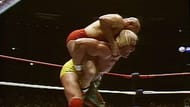The Golden Age (1984*-1993)
Hulk Hogan pinning the Iron Sheikh for the WWF World Heavyweight Championship - January 23, 1984.
Vince McMahon Jr’s takeover of the WWWF from his father set in motion the direction that the promotion would eventually take. Seeking to escape the territorial restrictions imposed by the National Wrestling Alliance and expand into a national promotion, Vince got working to bring WWF programming onto syndicated television across the United States. In order to generate sufficient revenue to secure television deals and recruit more talent, Vince adopted a mainstream approach to wrestling where he smudged the line between sport and entertainment. One of his decisions which bolstered the company in such a direction was the signing of Hulk Hogan.
Insane Vince McMahon ideas that got canceled - Watch Here!
Hulk Hogan’s popularity had soared post Rocky III. Though the role was limited, Thunderlips’s involvement in a major Hollywood franchise augmented his popularity, which shot to unprecedented heights. Despite being a mediocre ring worker, Hogan’s charisma, and audience drawing abilities were staggering. Vince had found the ideal candidate on whose shoulders to steer the company to television success. When contacted by the WWF, Hulk Hogan was still the top face at American Wrestling Association, a role he happily relinquished for a similar babyface gimmick at WWF.
Bob Backlund’s image makeover during the fag end of his WWF World Heavyweight Championship reign did not sit well with the audience. Seeking a substitute whom fans could idolize, the company looked no further than Hogan. Muscular, tall, and infinitely more charismatic, Hogan was a welcome change in the world title picture. To further increase viewership, WWF decided to cast the Iron Sheikh as a destructive foreign heel, whose camel clutch was impossible to escape from. Making him a transitional champion after getting Backlund to lose was the first step towards cementing Hogan’s legacy as the definitive redeeming hero.
Inside a jam-packed Madison Square Garden on the 23rd of January 1984, more than twenty thousand screaming and shouting fans witnessed the greatest six minutes in wrestling history. Having made a promo reeking of anti-American tirades and vainglorious assertions, the Iron Sheik with his manager, the Ayatollah Blassie, had already stirred the crowd and incurred the wrath of thousands. The selection of “Eye of the Tiger” as Hogan’s music further added to the storytelling. With Rocky III being the most recent addition to the American pop culture phenomena, WWF capitalized and pushed Hulk as the newcomer replacing and avenging an injured face (kayfabe). As Hogan sprinted to the ring, his veins pulsating and arms quivering, he seemed to be locked in a trance, feeding off the energy of every single fan that had been slighted by the Sheik’s spite. However, Hogan burst before the two heavyweights could lock horns and attacked Sheik while the latter was still in his ring gear. The arena erupted in a deluge of cheers.
Although most of the match saw either man pounding the other against the mat and the turnbuckle, with occasional kicks and jabs thrown in, it was also a display of some carefully arranged spots. Two of the most effective of these were Hogan’s countering of the Sheik’s Boston Crab as well as the unbeatable Camel Clutch. Previously, the camel clutch had conquered Bob Backlund’s reign. Coming in as a replacement and written as he was, it was incumbent on Hogan to reverse the clutch in the most striking manner possible. Having created some space between himself and the Sheik, the Hulkster proceeded to lift him on his back while standing erect and eventually shoved him onto the nearest turnbuckle. There was nothing to top this remarkable feat of strength and Hogan sealed the match with an atomic leg drop as the arena reverberated in a fever pitch. In the words of Gorilla Monsoon, “Hulkamania is here”.
This match would lead to the creation of one of the most recognizable performers to ever step between the ropes. Not only that, Hogan came to be seen as a benchmark for the way characters were supposed to be written. Over the top gimmicks, unbeatable baby faces, black and white characterization, spectacular rather than technical matches, and a fair share of moralizing on national television, were the hallmarks of the Golden Era. By the end of the decade, WWF had become a phenomenon in itself. With a roster full of exuberance and flash, such as Macho Man, Ultimate Warrior, Ric Flair and Roddy Piper, the company had strengthened its place at the top of entertainment charts. The rest of its history is about how it strove to maintain that position.
*Although the history books officially date The Golden Age to have begun in 1982, 1984 is a more accurate date.
Make Sportskeeda your preferred choice for WWE content by clicking here: Source preferences


